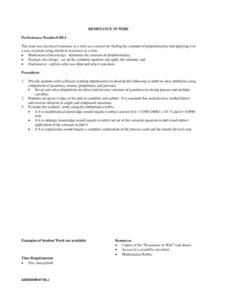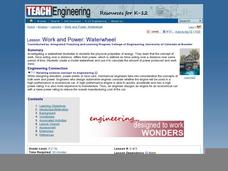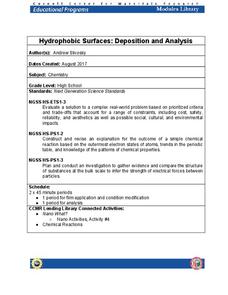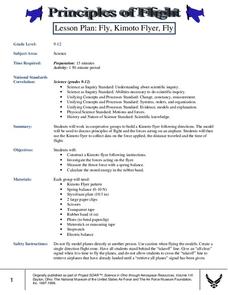Consumers Energy
The Cost of Electricity
How much is your toaster costing you every day? Young environmentalists calculate the monetary costs of household appliances based on their average consumption of wattage.
Curated OER
Residential Power System
Perform data analysis on energy consumption to apply algebraic expressions to the real world. Learners will write and solve equations that answer various questions from residential power use. They will collect data at home and calculate...
Curated OER
Electricity and Ohm's Law Lesson Plan
Students investigate the concept of Ohm's Law and how it is used when finding a solution to an equation. They use properties of equality in order to find the solution for the variable. Students also apply a formula to real life problems...
Teach Engineering
How a Hybrid Works
Work with your class to connect series and parallel circuits to hybrid cars. The lesson introduces basic circuit diagrams before having scholars apply the understanding of the difference between parallel and series circuits to hybrid cars.
Curated OER
The Quest For Power
Students investigate and apply properties of math. In this algebra and physics lesson, students define important vocabulary words to create a basic understanding of keywords. They perform experiments using concepts of electricity and math.
Curated OER
Trigonometric Functions of Special Angles
Students explore the concept of the six trigonometric functions, places where the functions can be utilized, and apply these functions to several electrical application problems.
Curated OER
What "Ohm's" You?
Students use the CBL and voltage probe to observe electricity. In this algebra activity, students use the TI calculator with the CBL to explore Ohm's Law. They discuss exponential equations and how it relates to Ohm's Law.
Curated OER
Unit Circle and Triangle
Students apply the Unit Circle to solve ratios of triangles. In this geometry lesson, students derive the different ratios of a triangle using the Pythagorean Theorem. They find the angles of a unit circle using a right triangle.
Curated OER
Resistance in a Wire
Students find the constant of proportionality and apply it to a situation. They use the electrical resistance in a wire as a context for finding the constant of proportionality. In addition, they write an explanation and justification of...
Curated OER
Budget Mania
Students examine several examples of budgets to develop a facility with the components of its formation. Income, expenses, and expenditures are considered and itemized for this instructional activity.
Curated OER
Cutting Corners - Parts 1 and 2
Students use optimization concepts to design their own container. In this optimization lesson plan, students understand how the optimization concept is critical in calculus and why products are packaged the way they are.
Curated OER
Energy Efficiency: It really IS important!
Students compare the energy needed to produce new products versus recycling. In this physics lesson, students brainstorm ways to save energy. They create a presentation about the correlation between conserving energy and energy costs.
Teach Engineering
Maximum Power Point
Investigate the maximum power output of a photovoltaic panel with a lesson that introduces the class to the maximum power point. Individuals learn how to determine the maximum power point of a solar panel by using Ohm's law and the power...
Curated OER
Work and Power: Waterwheel
Students investigate a waterwheel and the physical properties of energy. For this waterwheel lesson students create a model waterwheel and calculate the amount of power produced.
Curated OER
Power Crisis in California
Students read an online CNNfyi.com article related to the energy crisis in California. They calculate the monthly cost of running household appliances. They develop a list of alternative methods of energy sources.
Cornell University
Hydrophobic Surfaces—Deposition and Analysis
Couches, carpets, and even computer keyboards now advertise they are spill-resistant, but what does that mean? Scholars use physical and chemical methods to coat surfaces with thin films to test their hydrophobic properties. Then they...
California Academy of Science
Optimal and Sustainable: Renewable Energy Revamp
More than 100 cities around the world have shifted from fossil fuels to renewable energy sources. Scholars investigate a city wanting to make this switch, but needs help determining how to make the shift. Groups consider all options,...
Curated OER
Island Hopping
Students utilize a variety of math skills to explore the Turks and Caicos Islands, the British Territory to which South Caicos belongs. They select and apply quantitative data to support their recommendations for future investment and...
Curated OER
Creeping Sheets of Ice
Students conduct scientific investigation in which they observe glacial
effects on landscape, develop and explain their own theories of how glaciers change land, and demonstrate understanding and explain basic motion and force principles.
Curated OER
Principles of Flight
High schoolers explore the principles of flight. In this flight activity, students construct a model plane and investigate the forces acting on the flier. They will measure the thrust and calculate the stored energy.
Curated OER
Linear Systems
Students solve and graph linear equations. For this algebra lesson, students solve systems of equations using elimination and substitution. They graph their answer and identify the point of intersection.
Curated OER
Preparation for Engineering Careers
Students explore all the careers that deal with math, science, technology and engineering. They assess the importance of clearly explaing yourself in writing, making public presentations and utilizing technical jargon in dealing with...
Teach Engineering
The Challenge Question
A research position becomes a modeling job. The introductory activity in a series of nine presents the challenge of analyzing a set of bivariate data. The class brainstorms what the data may represent. Pupils must decide what is needed...
Teach Engineering
Applications of Linear Functions
It's not so straightforward — lines can model a variety of applications. Pupils experience linear relationships within the context of science, including Hooke's and Ohm's Laws. Class members got a taste of motion and speed from the...

























